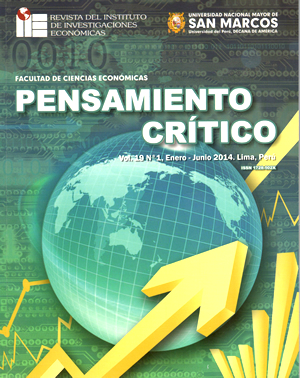Some notes on the objectives of the devaluation
DOI:
https://doi.org/10.15381/pc.v19i1.11025Keywords:
Institutions, institutional unemployment, devaluation, prices, wages.Abstract
This paper analyzes the theoretical foundations of the objectives of devaluation assuming the pattern Monetary Currency Freely Swinging is a tool designed to cause inflation. Was introduced to avoid the technical difficulties in its inflationary activity BCRs.
Economic history has shown that the Trade Unions, State Policies and Institutions (during times of bullish euphoria) to achieve higher wages to implement wage labor market have implemented institutional cause unemployment (despite the continued expansion of credit). But things get worse when, finally, the inevitable downturn occurs and begin to raise prices. These institutions reject any cuts in nominal wages so that unemployment will rise. ( Incidentally those workers who, despite everything, still working, will see increases in their nominal wages ). The millions of unemployed constitute serious threat to internal peace. Faced with a situation fraught with danger, governments come to depreciation. Since these institutions reject those coercively fixed wages are adjusted to the value of money and the price level; what they believe is appropriate to adjust the value of the currency and price levels to those coercively fixed wages. No coercion is that these wages are set too high; what happens is that the currency is overvalued relative to foreign currencies and, therefore, proceed to adjust the latter relationship. The depreciation will be the remedy.
Downloads
Published
Issue
Section
License
Copyright (c) 2014 Pablo Rivas Santos

This work is licensed under a Creative Commons Attribution-NonCommercial-ShareAlike 4.0 International License.
THE AUTHORS RETAIN THEIR RIGHTS:
a. The authors retain their trademark and patent rights, and also on any process or procedure described in the article.
b. The authors retain the right to share, copy, distribute, execute and publicly communicate the article published in Pensamiento Crítico (for example, place it in an institutional repository or publish it in a book), with recognition of its initial publication in Pensamiento Crítico.
c. The authors retain the right to make a subsequent publication of their work, to use the article or any part of it (for example: a compilation of their works, notes for conferences, thesis, or for a book), provided they indicate the source of publication (authors of the work, journal, volume, number and date).






